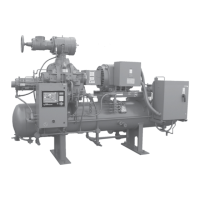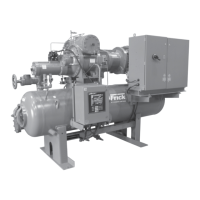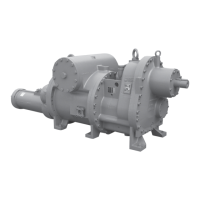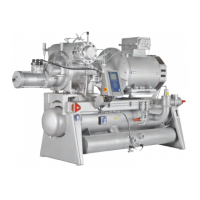RWB II ROTARY SCREW COMPRESSOR UNITS
MAINTENANCE
070.200-IOM (DEC 11)
Page 24
Frick provides a power assist kit consisting of a mounted
and wired solenoid valve and timer on all RWB II booster
compressors. High stage compressors are supplied with
a power assist kit when the design suction temperature is
less than or equal to 0°F. The wiring diagram in 090.020‑M
Quantum™LX manual shows the wiring included when re‑
quired. Introduction of high discharge pressure gas is made
to the check valve. A timer limits the high pressure gas to
only thirty seconds duration since intermediate gas pressure
and spring tension are sufficient to maintain closure on unit
shutdown. A metering valve is also provided for use as a
service valve and to allow discharge gas flow regulation to
prevent excessive force and resulting closure “hammering”.
SUCTION CHECK VALVE BYPASS
During normal operation, valve HV1 is closed. This is a pump‑
out connection to allow refrigerant removal to the system
suction prior to evacuation for servicing. Valve HV‑2 must
be open in most systems at all times. It should normally be
cracked open to allow the oil separator to slowly bleed down
to system suction pressure when the unit is stopped (having
this valve cracked open allows the compressor drive motor to
have an easier start, and the discharge check valve will seat
more tightly). If the drive coupling backspins, start closing the
valve until the backspin stops. If the separator oil level foams
excessively on shutdown, HV‑2 should be closed slightly. If
the separator takes more than 20 – 30 minutes to equalize
to suction pressure after shutdown, HV‑2 can be opened
slightly. See Figure 23.
Figure 23
NOTE: HV-2 should be closed on systems with suction
pressures below atmospheric pressure, to avoid the pos-
sibility of air leakage into the system during shutdown.
However, on high-stage or booster systems with check
valve, HV-2 can remain open.
HV‑2 also should be closed on systems that utilize autocycle
to restart the compressor, based on increase in system
suction pressure during shutdown, if slowly bleeding the
oil separator gas to suction will raise the suction pressure
enough to cause short cycling of the compressor.
Also it is important to close HV‑2, if the oil pump is to be run
for long periods of time with the compressor stopped, to avoid
oil being pumped up the suction line.
If multiple compressors are operated with a common
economizer vessel, it is necessary to install a back‑pressure
regulator valve with an electric shut‑off option in the vapor
line piped to the compressor's economizer port. If an electric
shut‑off is not installed in the economizer vapor line, valve
HV‑2 must remain closed to avoid a gas bypass from the
economizer line through the suction check valve bypass,
back to the suction line on a compressor that is shut down.
LOW AMBIENT OPERATION
It is recommended that oil separators be insulated as a
minimum requirement to preserve the heat generated by
the oil heaters. It is important that the coalescer end of the
separator be insulated to prevent refrigerant condensation.
On systems located outdoors or in unheated buildings where
the ambient temperature could drop below +40°F, insulating
and/or heat tracing of the compressor lube oil systems is
highly recommended.
When low ambient temperatures (below +20°F) are a pos‑
sibility, it is recommended that lube oil lines, oil filters, oil
pumps and oil coolers be heat traced and insulated.
Freeze‑up protection must also be provided for all water‑
cooled equipment
SUCTION CHECK VALVE
POWER ASSIST KIT
Low temperature booster compressor applications require
hot gas to assist the suction check valve closure. This is ac‑
complished by using the high pressure discharge gas from
the high pressure side of the system (power assist kit).
The power assist kit (Figure 24) is factory installed with the
discharge gas pressure being supplied from the high stage
discharge gas. The kit consists of a strainer, mounted and
wired solenoid valve, timer, and metering valve. The timer
limits the high pressure gas feed to the suction check valve
to thirty seconds via the solenoid valve. This is sufficient
time to warm the suction check valve piston and provide
proper operation. The metering valve is provided for use as
a service valve and to allow discharge gas flow regulation to
prevent excessive force and resulting closure "hammering".
The valve should be adjusted accordingly to prevent such
an occurrence.
POWER ASSIST KIT
POWER ASSIST TO BE CONNECTED TO
CONN IN CENTER OF MV END PLATE
HIGH PRESSURE GAS FROM HIGH
SIDE COMPRESSOR DISCHARGE
3/8 OD
1/2
1/2
COMPRESSOR
1/4
STR-4
S
YY
7
Figure 24 - Power Assist Kit

